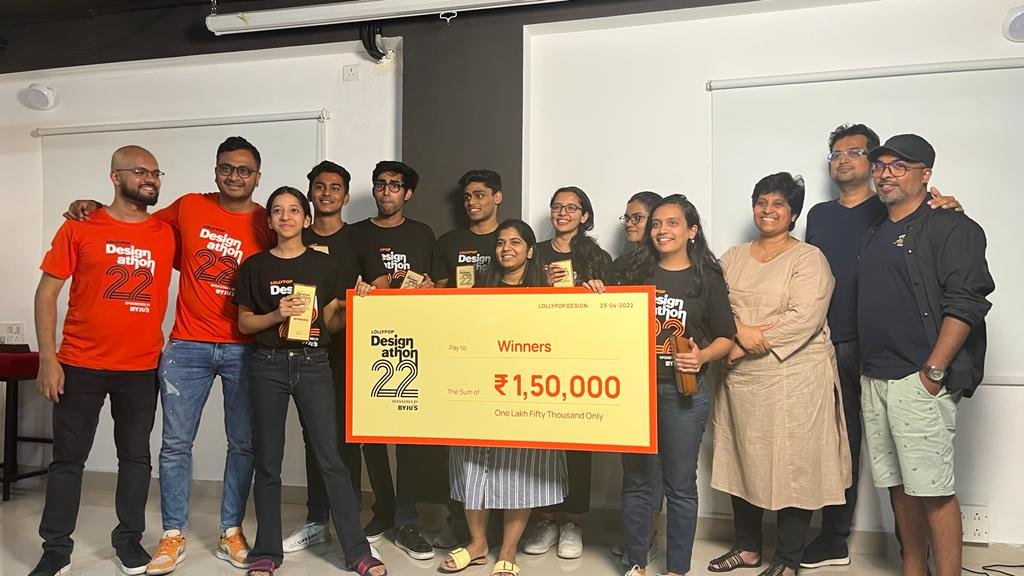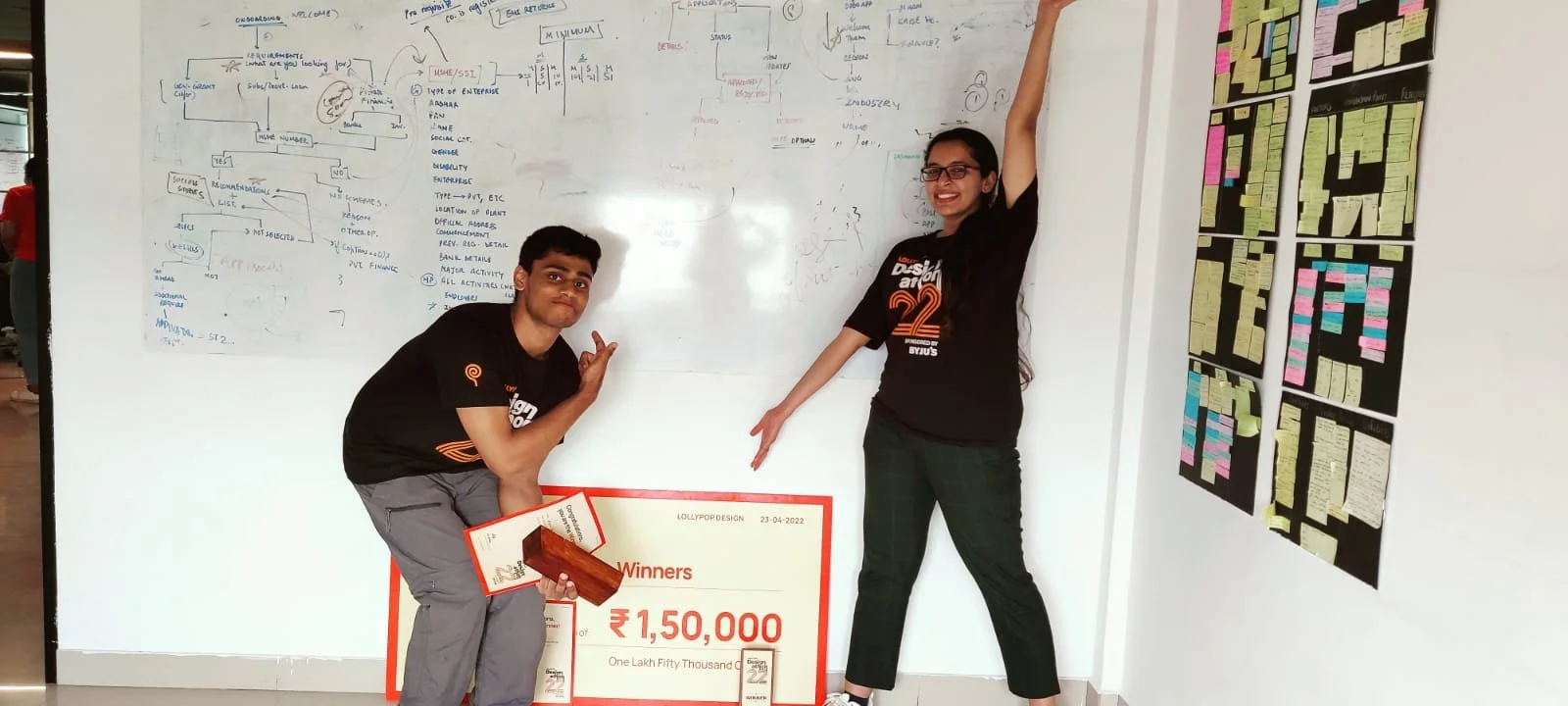
Sumitra
(Good Friend)
I spearheaded a team of 7 to design a platform that assists rural entrepreneurs in finding the right government schemes and enables them to apply with ease.
At A Glance
./Overview
001
Outcome
The Challenge
Sumitra; a good friend and solid support system to rural entrepreneurs who scale the obstacle-course of setting up and expanding their businesses alone.
Sumitra identifies and reduces the the redundancies in the application procedure by reducing the paperwork and form-filling.
It eases search and recommends best fitting schemes for their businesses and best suited to their industries.
Design a solution that would help bussing innovators and entrepreneurs in Rural India with respect to entrepreneurial awareness and opportunities.
My Role
Ensuring effective communication within the team while making sure that everyone had the opportunity to put forth their ideas, thoughts and opinions.
Streamlining the brainstorming process for the team by suggesting strategic points of convergence and divergence.
Research and User Interviews - I suggested that we go out of the venue and talk to members of the community around the vicinity.
I led the user flow creation and the Information Architecture Design which was key in easing the application process.
I supported the brand guide creation by suggesting the use of fonts which translate well across diverse regional languages.
I led the low-fi wireframe creation and rapid prototyping of the proposed B2C application.
1200 Applications, 80 Shortlisted Participants , 10 Teams, 1 Challenge
✦ that my team won ✦
Presented at
I got shortlisted to participate in Designathon 2022 conducted by Lollypop Design Studio and won first place!
It was a 24-hour sprint of solution oriented design with a (incredibly talented) team I met that day, (truly supportive) mentors from Adobe, Airtel and Microsoft, and the brilliant crew at Lollypop, Bangalore, IN.
Organized by
Collaborators
Tools
Figma, Whimsical, Physical Whiteboarding, FigJam
Platform
Accessible mobile application created for pan-Indian inclusion of regional languages.
Domain
Enhancing opportunity, awareness and information for rural entrepreneurs in India.
Context for the Designathon
Diving Deep
./The Design Process
002
DISCOVER
EMPATHIZE
DEFINE
IDEATE
DESIGN
PRESENT
Background Research: Literature Review, Competitive Analysis
User Interviews
Narrowing down the scope
Feature Ideation
Brand Guide Creation, Low and High fidelity wireframes, prototyping
Presenting before industry experts
Exploring THE WORLD OF RURAL ENTREPRENEURS
./Discover
003
The problem statement required us to empower rural entrepreneurs in the realms of awareness, opportunity, and education. We began with some foundational research and started to read about current problems and existing solutions. Here are a few of the key insights that we collected:
You can view a detailed summary of our work here: Executive Document
Cumbersome, long procedures of filing applications
Language and communication barriers
There are a variety of schemes and grants available across diverse industries
There is no dearth of funding or variety of the schemes that exist for rural businesses to expand. The Government spends close to ₹ 2 Lakh Crore on grants & schemes. We dug deeper to find what’s stopping them from accessing these opportunities.
Applying to government schemes was cumbersome and inaccessible due to language barriers. These were two of the biggest reasons why the business owners of rural India chose not to apply to existing schemes.
Getting to KNOW OUR USERS
./Empathise
004
Our target users were those who:
Ran their own business in rural India (P2, P3, P5)
Were trying to set-up a business in rural areas (P3, P4)
Worked closely with rural business owners (P6)
Recurring pain-points from User Interviews:
Lack of awareness of the range of schemes and grants
Assumption that the process is tedious and cumbersome.
Finding funds for set-up and/or expansion of business
Lack of Opportunity and Awareness
Lack of Awareness
Lack of Awareness
Participant Recruitment
We thus abstracted one User Persona:
Ramesh Kumar
Textile Weaver
Goals:
To expand his business
Needs:
Money to procure equipment like Looms to increase production
Obstacles:
Isn’t aware of government schemes to offer grants for subsidized equipment
Has a pre-conceived notion of government schemes to be complicated and intimidating
Guiding Question
./Define
005
How might we ease access of rural entrepreneurs to government schemes and make the process of seeking these schemes out easy to understand and follow through?
DESIGN Goals
./Define
006
Reduce Existing Redundancies
Reduce steps in form-filling by getting data stored under business registration certificates
Recommend Existing and News Schemes
This will make it easier for entrepreneurs to find schemes and grants relevant to them.
Translation Across Regional Languages
India has over 22 official languages hence it’s important to offer easy translation
REDUCING EXISTING REDUNDANCIES
./Ideate
007
The form had a total of 23 fields to be filled in and we reduced that to 11, thereby reducing the effort to less than 50%.
(Pictured: Arjun and I, who spotted the redundancies and cracked how to reduce them)
In line with our User Persona, we picked the EJ-2L scheme which offers weavers grants to buy equipment.
We saw that a lot of the form filling can be exponentially reduced by simply allowing the system to take details from the user’s KYC and Business Registration documents which can be stored within the App.
EJ-2L Application Form
Before
After
USER FLOW FOR THE APP
./Ideate
008
FEATURES
./Ideate
009
Translation Across Regional Languages
The app offers a language menu explicitly, pre-onboarding.
Offering Relevant Recommendations
By obtaining the industry information through the MSME number, Sumitra recommends best suited schemes and grants, making it easy for entrepreneurs to access.
Easy form filling and templatized help
With reduced fields to fill, users can easily upload their information and seek help wherever they find themselves to be confused
EVERYTHING WAS SUBSTANTIATED BY RESEARCH
./Key Insights
009
One of our most important considerations was to stop looking at rural India as still unfamiliar to tech. Our interviews and secondary research revealed that close to 67% of rural households use a smart phone on a daily basis and are incredibly tech-savvy. It was important to consider this when designing a digital solution.
Working for the solution overnight allowed us to zoom into only the most necessary features of the process but that didn’t keep us from extensively studying loan application forms and striking off manual-input fields. Each strike-off made us feel closer to creating a truly relaxing, easy experience.
Rural India is tech-savvy!
Careful review of existing loan application forms
What I learnt
./Key Insights
012
This was my first ever designathon, with 7 complete strangers who were suddenly my team. All of us came from different academic and professional backgrounds. I was flexible and often found myself moderating the conversations within the team to ensure that everyone was feeling heard and was up to speed with where we were proceeding. It was really validating to have my team mates tell me “I led well!” - a compliment of the highest honor.
Despite the intense timeline, we were consistently pushing for research based decisions to ensure that every move we make has an impact.
Even when working towards to identifying redundancies in the form-filling procedures, I was initially very overwhelmed because I had to familiarize myself with terms form the textile industry and the business innovation sector. But this was also why it was more gratifying to be able to simplify the form. It was exactly this feeling of intimidation by process that we were trying to eliminate.
Validating my Skill to Lead
Using ReSEARCH TO BACK IDEAS
Thank you for reading so far!










